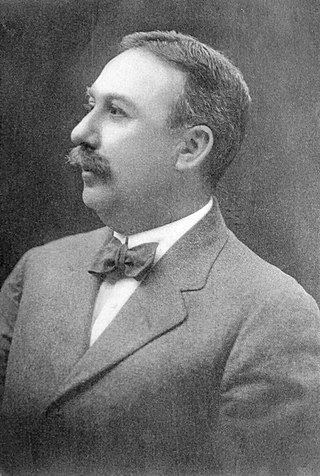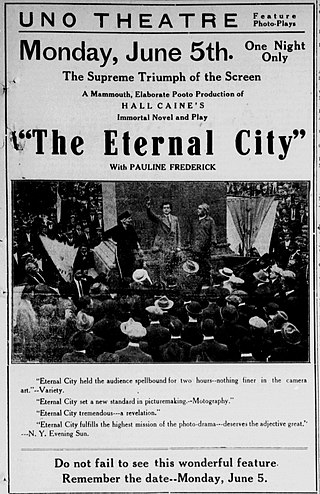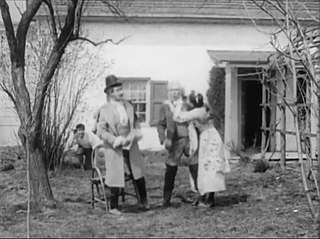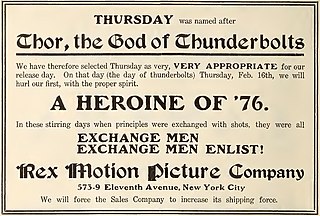Related Research Articles

The Great Train Robbery is a 1903 American silent film made by Edwin S. Porter for the Edison Manufacturing Company. It follows a gang of outlaws who hold up and rob a steam locomotive at a station in the American West, flee across mountainous terrain, and are finally defeated by a posse of locals. The short film draws on many sources, including a robust existing tradition of Western films, recent European innovations in film technique, the play of the same name by Scott Marble, the popularity of train-themed films, and possibly real-life incidents involving outlaws such as Butch Cassidy.

Edwin Stanton Porter was an American film pioneer, most famous as a producer, director, studio manager and cinematographer with the Edison Manufacturing Company and the Famous Players Film Company. Of over 250 films created by Porter, his most important include What Happened on Twenty-third Street, New York City (1901), Jack and the Beanstalk (1902), Life of an American Fireman (1903), The Great Train Robbery (1903), The European Rest Cure (1904), The Kleptomaniac (1905), Life of a Cowboy (1906), Rescued from an Eagle's Nest (1908), and The Prisoner of Zenda (1913).

Life of an American Fireman is a short, silent film Edwin S. Porter made for the Edison Manufacturing Company. It was shot late in 1902 and distributed early in 1903. One of the earliest American narrative films, it depicts the rescue of a woman and child from a burning building. It bears notable similarities to the 1901 British short film Fire!, directed by James Williamson.

The Edison Manufacturing Company, originally registered as the United Edison Manufacturing Company and often known as simply the Edison Company, was organized by inventor and entrepreneur Thomas Edison and incorporated in New York City in May 1889. It succeeded the Edison United Manufacturing Company, founded in 1886 as a sales agency for the Edison Lamp Company, Edison Machine Works, and Bergmann & Company, which made electric lighting fixtures, sockets, and other accessories. In April 1894, the Edison laboratory's Kinetoscope operation, which was about to be commercialized, was brought under the Edison Company umbrella. In 1900, the United Edison Manufacturing Company was evidently succeeded by the New Jersey–incorporated Edison Manufacturing Company. The company's assets and operations were transferred to Thomas A. Edison, Inc. in 1911.

The Eternal City is a 1915 American silent drama film directed by Hugh Ford and Edwin S. Porter, produced by Adolph Zukor. The movie stars Pauline Frederick in her debut film role, The production is based upon the 1901 novel and 1902 Broadway play of the same name by Hall Caine that starred Viola Allen and Frederic De Belleville. Much of The Eternal City was shot on location in England and Italy before being interrupted by the start of the Great War. The film was released through the specially created Select Film Booking Agency for the Famous Players Film Company.

The Night Before Christmas is a 1905 American silent short film directed by Edwin S. Porter for the Edison Manufacturing Company. It closely follows Clement Clarke Moore's 1823 poem Twas the Night Before Christmas, and was the first film production of the poem.
The Little Train Robbery is a 1905 American silent Western film directed by Edwin S. Porter. It is a parodic sequel/remake to Porter's 1903 film The Great Train Robbery with an all-child "cast as the robbers, and a miniature railroad and playhouse as sets."
Wallace McCutcheon Sr. was a pioneer cinematographer and director in the early American motion picture industry, working with the American Mutoscope & Biograph, Edison and American Star Film companies. McCutcheon's wealth of credits are often mixed up with the small handful of films directed by his son, Wallace McCutcheon Jr. (1884–1928).
The following is a list of films by Edwin S. Porter, head producer at the Edison Manufacturing Company owned by Thomas A. Edison, between 1900 and 1909. Later films were produced at the Rex Motion Picture Company and Famous Players Film Company.

The Miller's Daughter is a 1905 American silent film produced by Edison Manufacturing Company. Edison employees Wallace McCutcheon and Edwin S. Porter are generally credited as directors. The film is based on the melodrama Hazel Kirke by Steele MacKaye.

Dream of a Rarebit Fiend is a 1906 silent trick film directed by Edwin S. Porter for Edison Manufacturing Company. It is a seven-minute live-action film adaptation of the comic strip Dream of the Rarebit Fiend by American cartoonist Winsor McCay. The film was marketed as using several special effects in which "some of the photographic 'stunts' have never been seen or attempted before."

Kathleen Mavourneen is a 1906 silent short film by Edwin S. Porter, produced and distributed by Edison Manufacturing Company. It is based on the song “Kathleen Mavourneen” by Annie Crawford and Frederick Williams Nichols Crouch, which inspired the play by Dion Boucicault.

Kansas Saloon Smashers is a 1901 comedy short film produced and distributed by Edison Studios. Directed by Edwin S. Porter, it is a satire of American activist Carrie Nation. The film portrays Nation and her followers entering and destroying a saloon. After the bartender retaliates by spraying Nation with water, policemen order them out; the identities of the actors are not known. Inspiration for the film was provided by an editorial cartoon which appeared in the New York Evening Journal.

Éruption volcanique à la Martinique, released in the United States as The Eruption of Mount Pelee and in Britain as The Terrible Eruption of Mount Pelée and Destruction of St. Pierre, Martinique, is a 1902 French short silent film directed by Georges Méliès. The film is a short reconstruction, using miniature models, of a recent historical event: the eruption on 8 May 1902 of Mount Pelée, which destroyed the town of Saint-Pierre, Martinique.

The Count of Monte Cristo is a 1913 silent film adventure directed by Joseph A. Golden and Edwin S. Porter based on Alexandre Dumas' 1844 novel of the same name. It starred James O'Neill, a stage actor and father of playwright Eugene O'Neill. James O'Neill had been playing Edmond Dantès most of his adult life and was famous in the role. Daniel Frohman and Adolph Zukor produced together. Edwin S. Porter co-directed with Joseph Golden, though this was probably necessary as Porter also served as the film's cinematographer. The film was released on November 1, 1913.

Rex Motion Picture Company was an early film production company in the United States.

Uncle Josh at the Moving Picture Show is a 1902 American short silent comedy film directed by Edwin S. Porter, featuring a naive spectator trying to interact with films projected onto a screen. It is an almost identical remake of a British 1901 film directed by Robert W. Paul, The Countryman and the Cinematograph. Paul's film was the first to feature a film shown within a film.

Uncle Tom's Cabin is a 1903 American silent short drama directed by Edwin S. Porter and produced by the Edison Manufacturing Company. The film was adapted from the 1852 novel Uncle Tom's Cabin by Harriet Beecher Stowe. The plot streamlined the actual story to portray the film over the course of 19 minutes. The film was released on 3 August 1903 at the Huber's Fourteenth Street Museum in New-York.

The Train Wreckers is a 1905 American silent drama film, directed by Edwin S. Porter. In the film, the daughter of a railway switchman and lover of a locomotive engineer defeats outlaws trying to derail a train.
References
- ↑ Niver, Kemp (1967). Motion Pictures From The Library of Congress Paper Print Collection 1894-1912. University of California Press, ISBN 978-0520009479
- ↑ Edison Manufacturing Company. (April 20, 1907). Advertising copy: "Boone's daughter befriends an Indian maiden. Boone and companion start out on a hunting expedition. Boone's cabin attacked by the Indians. The desperate defense. Burning cabin. Abduction of Boone's daughters. Boone's return. The oath of vengeance. On the trail. The Indian camp. Escape of Boone's daughter. Discovery and pursuit. A friend in need. The fight. Defeat of the Indians. Capture of Boone. Surprising an Indian Picket. The fight on the cliff. Death of the Indian. Shoots the burning arrow into the Indian camp. Boone tied to the stake. War dance. Torturing Boone. Burning arrow lands in Indian camp. Indians become panic stricken. Rescue of Boone by his faithful horse. Desperate Bowie knife duel between Boone and Indian chief. Death of Indian chief. Tableau." Moving Picture World
- 1 2 Musser, Charles (1991). Before the Nickelodeon: Edwin S. Porter and the Edison Manufacturing Company. University of California Press, ISBN 9780520060807